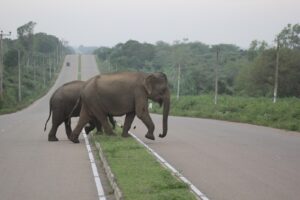Physical Address
23,24,25 & 26, 2nd Floor, Software Technology Park India, Opp: Garware Stadium,MIDC, Chikalthana, Aurangabad, Maharashtra – 431001 India
Physical Address
23,24,25 & 26, 2nd Floor, Software Technology Park India, Opp: Garware Stadium,MIDC, Chikalthana, Aurangabad, Maharashtra – 431001 India

The Sri Lankan government has launched a bold and transformative initiative to decisively address the escalating human-elephant conflict (HEC) by deploying a cutting-edge electric fencing system. Spearheaded by the National Engineering Research and Development Center (NERD), this groundbreaking effort is a direct response to the surge in dangerous encounters between humans and elephants, aiming to protect both vulnerable communities and endangered wildlife.
This high-impact initiative is being rolled out at the Weerawila Open Prison in the Hambantota District, a hotspot for frequent and destructive human-elephant clashes. The state-of-the-art electric fence, designed to be both effective and sustainable, is poised to set a new standard for conflict mitigation. If successful, it will serve as a replicable blueprint for tackling HEC in other high-risk regions across Sri Lanka, marking a significant step forward in the nation’s conservation and public safety efforts.
A Complex and Escalating Conflict
Sri Lanka has one of the most complex human-elephant conflicts in the world. With the highest elephant deaths due to human actions and the second-largest human deaths caused by elephants globally, the country faces an urgent need for effective and sustainable solutions. While having a conversation with Supun Lahiru Prakash, Chair of the Human-Elephant Coexistence Subcommittee at the Wildlife and Nature Protection Society of Sri Lanka, he said that electric fences remain the most effective mitigation tool to date. However, their success depends on three critical factors: proper placement based on elephant home ranges, the strength of voltage, and consistent maintenance.
Recent incidents have demonstrated the negative impact of removing elephants from villages and relocating them to protected areas, as this disrupts their natural home range and intensifies the conflicts. Alarmingly, 60% of Sri Lanka’s land area is inhabited by elephants, with only 20% residing in protected areas and 40% scattered across non-protected regions. Addressing HEC requires a balanced approach that considers both conservation efforts and human safety.
Dive into our earlier article exploring on the Human-Elephant Conflict in Batticaloa
Prakash further explained that past unplanned actions have led to serious consequences. In Yala National Park’s Lunugamvehera region, female elephants have lost their calves due to a lack of food availability. Moreover, previously, Minneriya Reservoir provided abundant food resources during the dry season when the water levels dropped, revealing fine grasses that elephants relied on. However, following the Moragahakanda project, the reservoir remains filled year-round, eliminating this crucial food source. Consequently, tourist sightings of elephants in the Minneriya region have significantly declined. He emphasized that responsible authorities must implement better water management strategies rather than simply storing water.
Types of Electric Fences in Sri Lanka
The National Action Plan (2020) for mitigating HEC outlines four types of electric fences deployed across Sri Lanka:
The newly launched electric fence at Weerawila Open Prison can be considered a conventional fence. While hanging fences are already placed in other areas of the country, where some are successful and some are not, the unique feature of this Weerawila fence is its automated damage notification system, which sends an SMS alert to authorities when a breach occurs, enabling urgent repairs.
Innovative Engineering for Better Protection
NERD’s electric fence innovation stands out due to its improved durability and efficiency. Unlike the previous 5.5-foot-high fences, which elephants easily dismantled, the new design features 16-foot-high curved concrete pillars, making it significantly harder for elephants to topple them. This innovation has undergone extensive testing to ensure it remains operational during thunderstorms and provides an alert system when an elephant makes contact.
The Weerawila project, covering a four-kilometer stretch of the 157-acre open prison premises, was funded by the Prisons Decentralized Fund at a cost of Rs. 18 million. The Prisons Department Engineer Ranjaya Jayasekara told the Sunday Times that, the initiative aims to prevent elephants from breaching the prison grounds and destroying cultivated crops, a recurring issue under the old fencing system.
A Call for Sustainable, Long-Term Solutions
While technological advancements in fencing offer promising results, Mr. Prakash highlights the hidden repercussions of past unplanned actions, such as the mass translocation of elephants to holding grounds, which disrupts their natural habitat and food sources.
To ensure the success of HEC mitigation, Prakash emphasizes the need for joint efforts from government bodies, NGOs, farmer organizations, and the Department of Wildlife Conservation. He calls for habitat enrichment by removing invasive plant species and restoring natural grazing areas. Water management strategies should also be implemented to balance agricultural needs with wildlife conservation.
Explore our in-depth article on Sustainable Solutions for Human Elephant Conflict
Evaluating the Impact of New Electric Fencing
Despite the promising features of NERD’s electric fence, experts caution against premature conclusions regarding its effectiveness. Prakash asserts that the real impact of the newly implemented fence system can only be evaluated after at least one year of operation. Continuous monitoring and maintenance are crucial to prevent environmental factors, such as tree falls, from damaging the fence.
Sri Lanka’s efforts to address HEC are commendable, but sustainable solutions must go beyond electric fencing. Strategic conservation planning, habitat restoration, and community-driven initiatives are essential to fostering long-term coexistence between humans and elephants. The success of the Weerawila project will serve as a crucial benchmark for future mitigation efforts, shaping policies that prioritize both human safety and elephant conservation.
Reference:
https://link.springer.com/article/10.1007/s10531-023-02650-7
https://science.sjp.ac.lk/insoc/wp-content/uploads/sites/37/2023/11/A-HEC-NationalActionPlan-LR.pdf
https://iesl.lk/SLEN/60/Solving_Human%E2%80%93Elephant_Conflict.php
Banner Image by Supun Lahiru Prakash